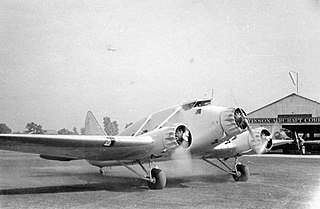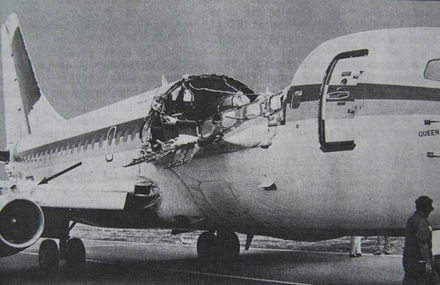
Aeroelasticity is the branch of physics and engineering that studies the interactions between the inertial, elastic, and aerodynamic forces that occur when an elastic body is exposed to a fluid flow. The study of aeroelasticity may be broadly classified into two fields: static aeroelasticity, which deals with the static or steady state response of an elastic body to a fluid flow; and dynamic aeroelasticity, which deals with the body's dynamic response.
In materials science, fatigue is the weakening of a material caused by cyclic loading that results in progressive and localized structural damage and the growth of cracks. Once a crack has initiated, each loading cycle will grow the crack a small amount, typically producing striations on some parts of the fracture surface. The crack will continue to grow until it reaches a critical size, which occurs when the stress intensity factor of the crack exceeds the fracture toughness of the material, producing rapid propagation and typically complete fracture of the structure.

Wear is the damaging, gradual removal or deformation of material at solid surfaces. Causes of wear can be mechanical or chemical. The study of wear and related processes is referred to as tribology.

Aloha Airlines Flight 243 was a scheduled Aloha Airlines flight between Hilo and Honolulu in Hawaii. On April 28, 1988, a Boeing 737-297 serving the flight suffered extensive damage after an explosive decompression in flight, but was able to land safely at Kahului Airport on Maui. There was one fatality, flight attendant Clarabelle Lansing, who was ejected from the airplane. Another 65 passengers and crew were injured. Despite the substantial damage inflicted by the decompression, and the loss of one cabin crew member, the safe landing of the aircraft established the incident as a significant event in the history of aviation, with far-reaching effects on aviation safety policies and procedures.
Damage tolerance is a property of a structure relating to its ability to sustain defects safely until repair can be effected. The approach to engineering design to account for damage tolerance is based on the assumption that flaws can exist in any structure and such flaws propagate with usage. This approach is commonly used in aerospace engineering, mechanical engineering, and civil engineering to manage the extension of cracks in structure through the application of the principles of fracture mechanics. In engineering, a structure is considered to be damage tolerant if a maintenance program has been implemented that will result in the detection and repair of accidental damage, corrosion and fatigue cracking before such damage reduces the residual strength of the structure below an acceptable limit.
In safe-life design, products are intended to be removed from service at a specific design life.

Chalk's Ocean Airways Flight 101 was an aircraft crash that occurred off Miami Beach, Florida, in the United States on December 19, 2005. All 20 passengers and crew on board the 1947 Grumman G-73T Turbine Mallard died in the crash, which was attributed to metal fatigue on the starboard wing resulting in separation of the wing from the fuselage.
Hydrogen damage is the generic name given to a large number of metal degradation processes due to interaction with hydrogen.

The 1977 Dan-Air/IAS Cargo Boeing 707 crash was a fatal accident involving a Boeing 707-321C cargo aircraft operated by Dan Air Services Limited on behalf of International Aviation Services Limited, which had been sub-contracted by Zambia Airways Corporation to operate a weekly scheduled all-cargo service between London Heathrow and the Zambian capital Lusaka via Athens and Nairobi. The aircraft crashed during approach to Lusaka Airport, Zambia, on 14 May 1977. All six occupants of the aircraft were killed.

Crocodile cracking, also called alligator cracking and perhaps misleadingly fatigue cracking, is a common type of distress in asphalt pavement. The following is more closely related to fatigue cracking which is characterized by interconnecting or interlaced cracking in the asphalt layer resembling the hide of a crocodile. Cell sizes can vary in size up to 11.80 inches (300 mm) across, but are typically less than 5.90 inches (150 mm) across. Fatigue cracking is generally a loading failure, but numerous factors can contribute to it. It is often a sign of sub-base failure, poor drainage, or repeated over-loadings. It is important to prevent fatigue cracking, and repair as soon as possible, as advanced cases can be very costly to repair and can lead to formation of potholes or premature pavement failure.

Electronic components have a wide range of failure modes. These can be classified in various ways, such as by time or cause. Failures can be caused by excess temperature, excess current or voltage, ionizing radiation, mechanical shock, stress or impact, and many other causes. In semiconductor devices, problems in the device package may cause failures due to contamination, mechanical stress of the device, or open or short circuits.

On 31 December 1968 a Vickers Viscount aircraft departed from Perth, Western Australia for a flight of 724 nautical miles (1 341 km) to Port Hedland. The aircraft crashed 28 nautical miles (52 km) short of its destination with the loss of all twenty-six people on board. More than half of the right wing, from outboard of the inner engine to the wingtip, including the outer engine and its propeller, broke away from the rest of the aircraft in flight and struck the ground a significant distance from the main wreckage. Investigation by the Australian Department of Civil Aviation and British Aircraft Corporation concluded that a mysterious action during maintenance led to extensive fatigue cracking in the right wing spar. This accident remains the third worst in Australia's civil aviation history.

On 31 January 1945 a Stinson Model A aircraft departed from Melbourne for a flight of 127 nautical miles (235 km) to Kerang, Victoria—the first leg of an Australian National Airways regular scheduled service to Broken Hill, New South Wales. It crashed 50 nmi (93 km) from Melbourne. All ten occupants were killed in the accident. The aircraft was one of four Stinsons imported in 1936 by Airlines of Australia (AoA). Three had now crashed with the loss of 17 lives, and the fourth would not be permitted to fly again.
Sustained load cracking, or SLC, is a metallurgical phenomenon that occasionally develops in pressure vessels and structural components under stress for sustained periods of time.
An Electrochemical Fatigue Crack Sensor (EFCS) is a type of low cost electrochemical nondestructive dynamic testing method used primarily in the aerospace and transportation infrastructure industries. The method is used to locate surface-breaking and slightly subsurface defects in all metallic materials. In bridge structures, EFCS is used at known fatigue susceptible areas, such as sharp-angled coped beams, stringer to beam attachments, and the toe of welds. This dynamic testing can be a form of short term or long term monitoring, as long as the structure is undergoing dynamic cyclic loading.
Polymer fracture is the study of the fracture surface of an already failed material to determine the method of crack formation and extension in polymers both fiber reinforced and otherwise. Failure in polymer components can occur at relatively low stress levels, far below the tensile strength because of four major reasons: long term stress or creep rupture, cyclic stresses or fatigue, the presence of structural flaws and stress-cracking agents. Formations of submicroscopic cracks in polymers under load have been studied by x ray scattering techniques and the main regularities of crack formation under different loading conditions have been analyzed. The low strength of polymers compared to theoretically predicted values are mainly due to the many microscopic imperfections found in the material. These defects namely dislocations, crystalline boundaries, amorphous interlayers and block structure can all lead to the non-uniform distribution of mechanical stress.

A cascade chart is tool that can be used in damage tolerance analysis to determine the proper inspection interval, based on reliability analysis, considering all the context uncertainties. The chart is called a "cascade chart" because the scatter of data points and downward curvature resembles a waterfall or cascade. This name was first introduced by Dr. Alberto W Mello in his work "Reliability prediction for structures under cyclic loads and recurring inspections". Materials subject to cyclic loads, as shown in the graph on the right, may form and propagate cracks over time due to fatigue. Therefore, it is essential to determine a reliable inspection interval. There are numerous factors that must be considered to determine this inspection interval. The non-destructive inspection (NDI) technique must have a high probability of detecting a crack in the material. If missed, a crack may lead the structure to a catastrophic failure before the next inspection. On the other hand, the inspection interval cannot be too frequent that the structure's maintenance is no longer profitable.
Welding is a manufacturing method used to join various materials in order to form an assembly. During welding, joints are formed between two or more separate pieces of material. A welded joint subjected to cyclic loading could fail due to fatigue. Fatigue results from this cyclic loading, as well as strains, in the material. Throughout a welded assembly's life, cracks, which reduce the fatigue life of a joint, could initiate, propagate, and grow causing the assembly to fail even if these cyclic stresses are low and smaller than the base material and weld filler material yield stress. Hence, the fatigue strength of a welded joint does not correlate to the fatigue strength of the base material. Incorporating design considerations in the development phase can reduce failures due to fatigue in welded joints.

Tribo-Fatigue is a subdiscipline of mechanics, which studies wear-fatigue damage (WFD) in and the fracture of tribo-fatigue systems. The field was founded at the junction of tribology, and mechanics of fatigue damage and fracture in materials and structural elements. The founder of Tribo-Fatigue is Professor L. A. Sosnovskiy

Fatigue testing is a specialised form of mechanical testing that is performed by applying cyclic loading to a coupon or structure. These tests are used either to generate fatigue life and crack growth data, identify critical locations or demonstrate the safety of a structure that may be susceptible to fatigue. Fatigue tests are used on a range components from coupons through to full size test articles such as automobiles and aircraft.












